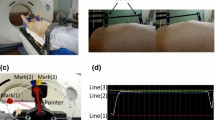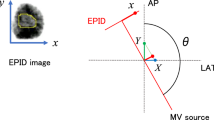Background and Purpose:
Several methods have been developed to reduce tumor motions and patient movements during radiotherapy of lung cancer. In this study, a multislice CT-based analysis was performed to examine the effect of a thermoplastic patient immobilization system on the chest wall and tumor motions.
Patients and Methods:
Ten patients with stage II–IV lung cancer were enrolled into the study. According to tumor localization, five patients had peripheral, and five patients central lung cancer (T2–T4). In total, six series of measurements were made with a multislice CT scanner, both with and without mask fixation, in normal breathing, at maximal tidal volume inhalation, and at maximal tidal volume exhalation.
Results:
Movements of chest wall, diaphragm and tumor, with and without mask, under different breathing conditions were registered. With the use of the immobilization system, no significant difference was found in diaphragmatic movements (mean deviation of diaphragm: 41.7–40.5 mm to the right, and 40.5–36.8 mm to the left side) and in tumor motions (mean deviation of tumor: 15.3–12.4 mm in craniocaudal, and 11.5–8.8 mm in posterolateral direction, mean medial deviation: 4.6–4.1 mm, mean lateral deviation: 7.2–5 mm). Significant differences were observed concerning tumor motions in anteroposterior direction (mean: 8.9–6.3 mm) and transverse chest movements in anteroposterior direction.
Conclusion:
Besides the advantage of optimal patient positioning, the movements of the bony chest wall can be considerably reduced by using the immobilization system. However, this fixation system has limitations concerning its suitability for minimizing tumor motions.
Hintergrund und Ziel:
Zahlreiche Methoden wurden entwickelt, um die Tumor- und Patientenbewegungen während der Strahlentherapie von Lungenkarzinomen zu reduzieren. In dieser Studie wurde eine Mehrschicht-CT-basierte Analyse zur Untersuchung der Auswirkungen eines thermoplastischen Patientenimmobilisierungssystems auf die Thoraxwand- und Tumorbewegungen durchgeführt.
Patienten und Methodik:
Zehn Patienten mit Lungenkrebs Stadium II–IV wurden in die Studie eingeschlossen. Gemäß der Tumorlokalisation wiesen fünf Patienten ein peripheres und fünf Patienten ein zentrales Lungenkarzinom auf (T2–T4). Insgesamt wurden sechs Messserien mit einem Mehrschicht-CT-Scanner durchgeführt: mit und ohne Maskenfixierung, bei normaler Atmung sowie mit maximalem Atemvolumen bei Ein- und Ausatmung.
Ergebnisse:
Die Brustwand-, Zwerchfell- und Tumorbewegungen wurden mit und ohne Maske bei unterschiedlichen Atmungszuständen registriert. Bei Verwendung des Immobilisierungssystems wurden keine signifikanten Unterschiede in den Zwerchfellbewegungen (durchschnittliche Abweichung des Diaphragmas: 41,7–40,5 mm nach links und 40,5–36,8 mm nach rechts) und den Tumorbewegungen (durchschnittliche Abweichung des Tumors: 15,3–12,4 mm in kraniokaudaler und 11,5–8,8 mm in posteroanteriorer Richtung, durchschnittliche mediale Abweichung: 4,6–4,1 mm, durchschnittliche laterale Abweichung 7,2–5 mm) festgestellt. Signifikante Unterschiede waren bezüglich der Tumorbewegungen in anteroposteriorer Richtung (durchschnittlich 8,9–6,3 mm) und der transversalen Brustkorbbewegungen in anteroposteriorer Richtung zu beobachten.
Schlussfolgerung:
Neben dem Vorteil einer optimalen Patientenpositionierung können die Bewegungen der Thoraxwand mit Hilfe des Immobilisierungssystems erheblich reduziert werden. Dieses Fixierungssystem hat jedoch auch Grenzen hinsichtlich seiner Eignung zur Minimierung der Tumorbewegungen.
Similar content being viewed by others
Author information
Authors and Affiliations
Corresponding author
Rights and permissions
About this article
Cite this article
Kovacs, A., Hadjiev, J., Lakosi, F. et al. Thermoplastic Patient Fixation. Strahlenther Onkol 183, 271–278 (2007). https://doi.org/10.1007/s00066-007-1681-6
Received:
Revised:
Issue Date:
DOI: https://doi.org/10.1007/s00066-007-1681-6




